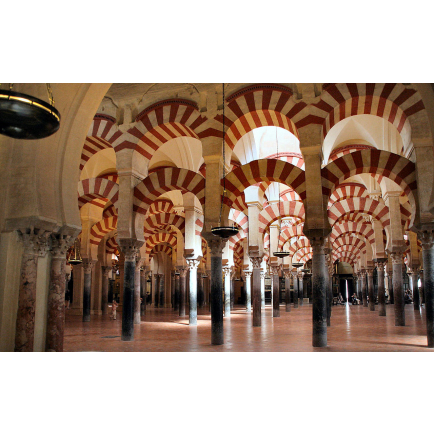
The Evolution of Islamic Arches
تاريخ الاضافة
10/07/2019
نوع المحتوى
Article
الرابط للمحتوى
الكاتب
Tasha Brandstatter
الناشر
classroom.synonym.com
Year of Publication
2017
الوصف
The Great Mosque atCordoba, Spain, is famous for its
hypostyle hall with horseshoe arches. Arches are important in Islamic
architecture, because of their symbolic significance and how they allow
builders to create mosques that reflect the importance of precepts such as
unity, beauty and light in the Muslim faith. The earliest mosques were open
courtyards surrounded by arcades, or a row of arches. This eventually developed
into a hypostyle hall, or space with a series of pillars. In Islamic
architecture, these rows of arches symbolize the division between sacred and
secular space. Horseshoe Arch
The first use of arches in Islamic architecture
included rounded arches similar to those found in Roman and Byzantine
architecture, but these quickly developed into the horseshoe arch. In the horseshoe
arch, the half-circle of the arch starts to turn in on itself before meeting
the top of its supporting columns. The hypostyle hall in the Great Mosque at
Cordoba, Spain, is a classic example of this type of arch. The shape of the
horseshoe arch allowed architects to achieve greater height in the arches and
it gave an opportunity for greater visual pattern and rhythm in the design.
Transverse
Arch
The use of the transverse arch, in which the arch
structurally spans the space between a pillar and the wall instead of another
pillar, allowed architects to use slimmer pillars instead of thick columns in
arcades. This innovation was adopted by European architects and eventually used
in many Gothic cathedrals. Coupled with the four-centered arch -- a low,
slightly pointed arch shape that has a center of gravity below the crown of the
pillars -- transverse arches allowed Islamic architects to cover large spaces
and led to the development of the pointed arch.
Pointed
Arch
Many art historians believe the pointed arch originated
in Islamic architecture. As early as The Dome of the Rock, built in 691, one
sees arches with a slight point. The pointed arch had a major architectural
advantage in that it centered the load-bearing thrust of the building on a
vertical point, so that more of the building's weight could be supported on the
exterior, usually with the use of buttresses, instead of with walls and
interior columns. This allowed for thinner pillars, higher ceilings, the
support of larger domes and overall gave the building a lighter, more open
feel. Multifoil Arches Sometimes called the cusped arch, multifoil arches
contain arches within arches. This style of arch was very common in Moorish
architecture and some examples can be found in the Great Mosque in Cordoba,
alongside horseshoe arches. The main architectural benefit to multifoil arches
is decorative -- like horseshoe arches, they provide opportunity for greater
visual pattern and rhythm; and indeed the shape of multifoil arches was
completely removed from arches to become a pattern motif on some buildings.
But, like the pointed arch, multifoil arches also centered the thrust of the
weight they carried to a single vertical point, which allowed for all the
structural benefits of a pointed arch.





